General Studies of Dementia in Australia and China
VerifiedAdded on 2023/04/24
|7
|1653
|232
AI Summary
The article analyzes the impact of dementia in other countries and how it affects the general community. The article focuses on China, where dementia is the most neurodegenerative disease among the elderly, accounting for up to 20 percent of the entire population.
Contribute Materials
Your contribution can guide someone’s learning journey. Share your
documents today.
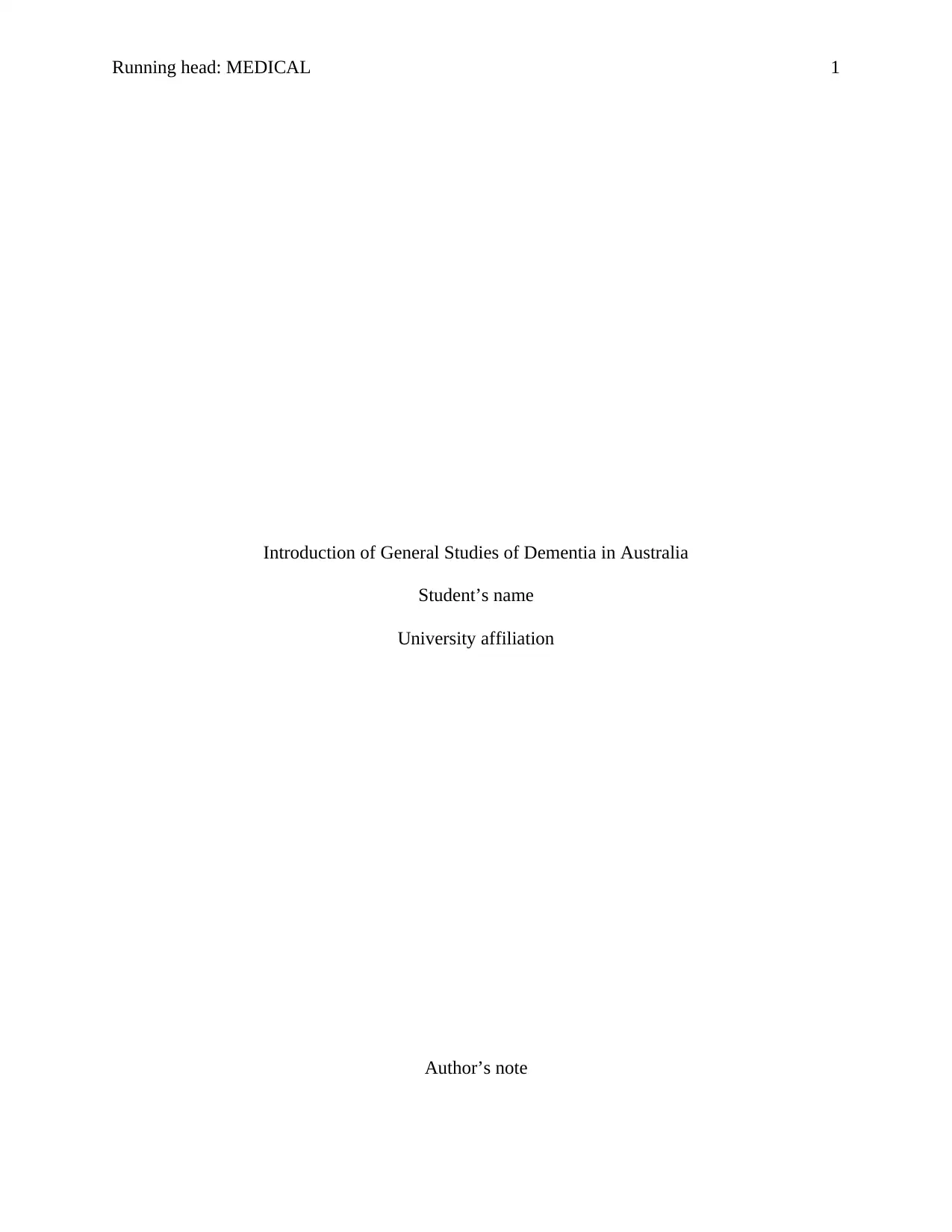
Running head: MEDICAL 1
Introduction of General Studies of Dementia in Australia
Student’s name
University affiliation
Author’s note
Introduction of General Studies of Dementia in Australia
Student’s name
University affiliation
Author’s note
Secure Best Marks with AI Grader
Need help grading? Try our AI Grader for instant feedback on your assignments.
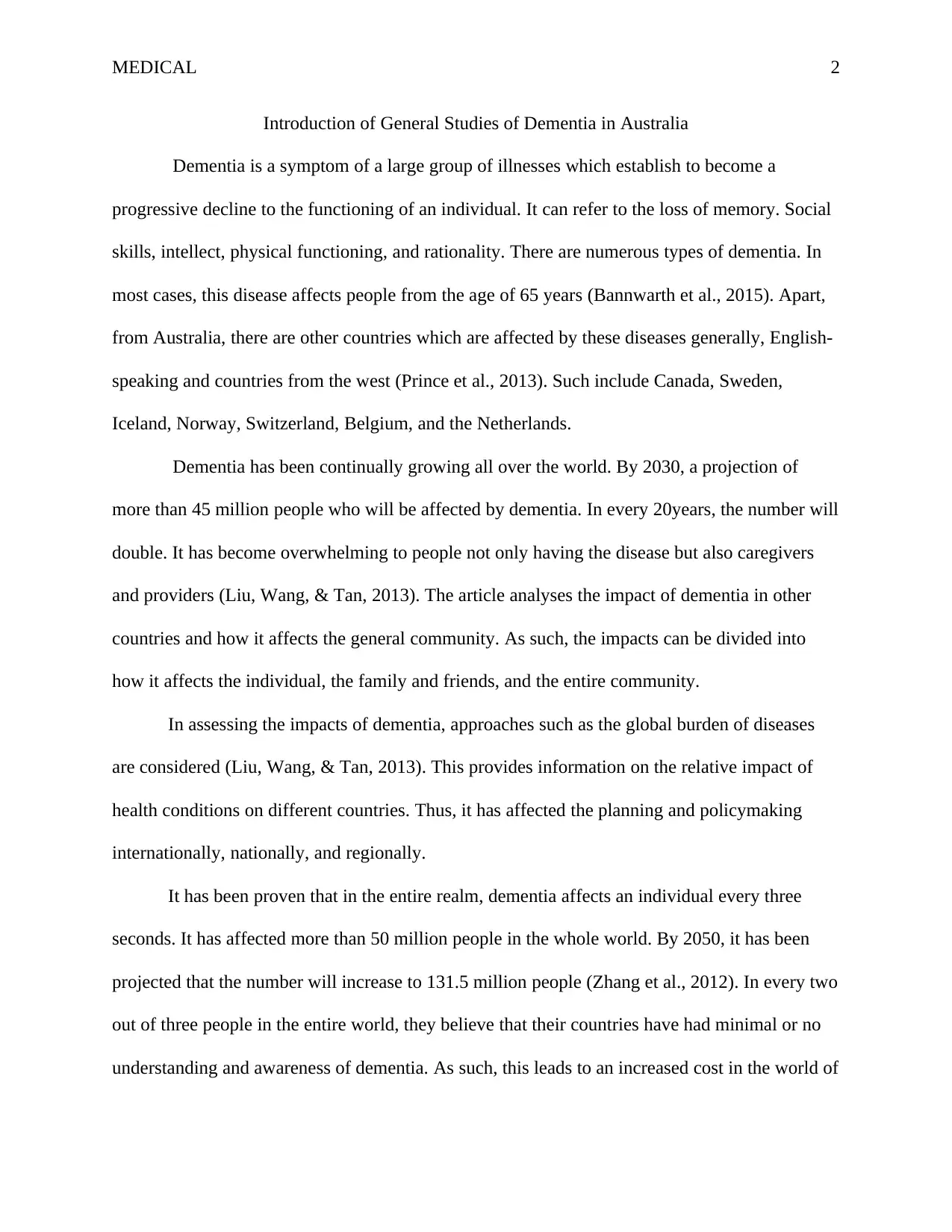
MEDICAL 2
Introduction of General Studies of Dementia in Australia
Dementia is a symptom of a large group of illnesses which establish to become a
progressive decline to the functioning of an individual. It can refer to the loss of memory. Social
skills, intellect, physical functioning, and rationality. There are numerous types of dementia. In
most cases, this disease affects people from the age of 65 years (Bannwarth et al., 2015). Apart,
from Australia, there are other countries which are affected by these diseases generally, English-
speaking and countries from the west (Prince et al., 2013). Such include Canada, Sweden,
Iceland, Norway, Switzerland, Belgium, and the Netherlands.
Dementia has been continually growing all over the world. By 2030, a projection of
more than 45 million people who will be affected by dementia. In every 20years, the number will
double. It has become overwhelming to people not only having the disease but also caregivers
and providers (Liu, Wang, & Tan, 2013). The article analyses the impact of dementia in other
countries and how it affects the general community. As such, the impacts can be divided into
how it affects the individual, the family and friends, and the entire community.
In assessing the impacts of dementia, approaches such as the global burden of diseases
are considered (Liu, Wang, & Tan, 2013). This provides information on the relative impact of
health conditions on different countries. Thus, it has affected the planning and policymaking
internationally, nationally, and regionally.
It has been proven that in the entire realm, dementia affects an individual every three
seconds. It has affected more than 50 million people in the whole world. By 2050, it has been
projected that the number will increase to 131.5 million people (Zhang et al., 2012). In every two
out of three people in the entire world, they believe that their countries have had minimal or no
understanding and awareness of dementia. As such, this leads to an increased cost in the world of
Introduction of General Studies of Dementia in Australia
Dementia is a symptom of a large group of illnesses which establish to become a
progressive decline to the functioning of an individual. It can refer to the loss of memory. Social
skills, intellect, physical functioning, and rationality. There are numerous types of dementia. In
most cases, this disease affects people from the age of 65 years (Bannwarth et al., 2015). Apart,
from Australia, there are other countries which are affected by these diseases generally, English-
speaking and countries from the west (Prince et al., 2013). Such include Canada, Sweden,
Iceland, Norway, Switzerland, Belgium, and the Netherlands.
Dementia has been continually growing all over the world. By 2030, a projection of
more than 45 million people who will be affected by dementia. In every 20years, the number will
double. It has become overwhelming to people not only having the disease but also caregivers
and providers (Liu, Wang, & Tan, 2013). The article analyses the impact of dementia in other
countries and how it affects the general community. As such, the impacts can be divided into
how it affects the individual, the family and friends, and the entire community.
In assessing the impacts of dementia, approaches such as the global burden of diseases
are considered (Liu, Wang, & Tan, 2013). This provides information on the relative impact of
health conditions on different countries. Thus, it has affected the planning and policymaking
internationally, nationally, and regionally.
It has been proven that in the entire realm, dementia affects an individual every three
seconds. It has affected more than 50 million people in the whole world. By 2050, it has been
projected that the number will increase to 131.5 million people (Zhang et al., 2012). In every two
out of three people in the entire world, they believe that their countries have had minimal or no
understanding and awareness of dementia. As such, this leads to an increased cost in the world of
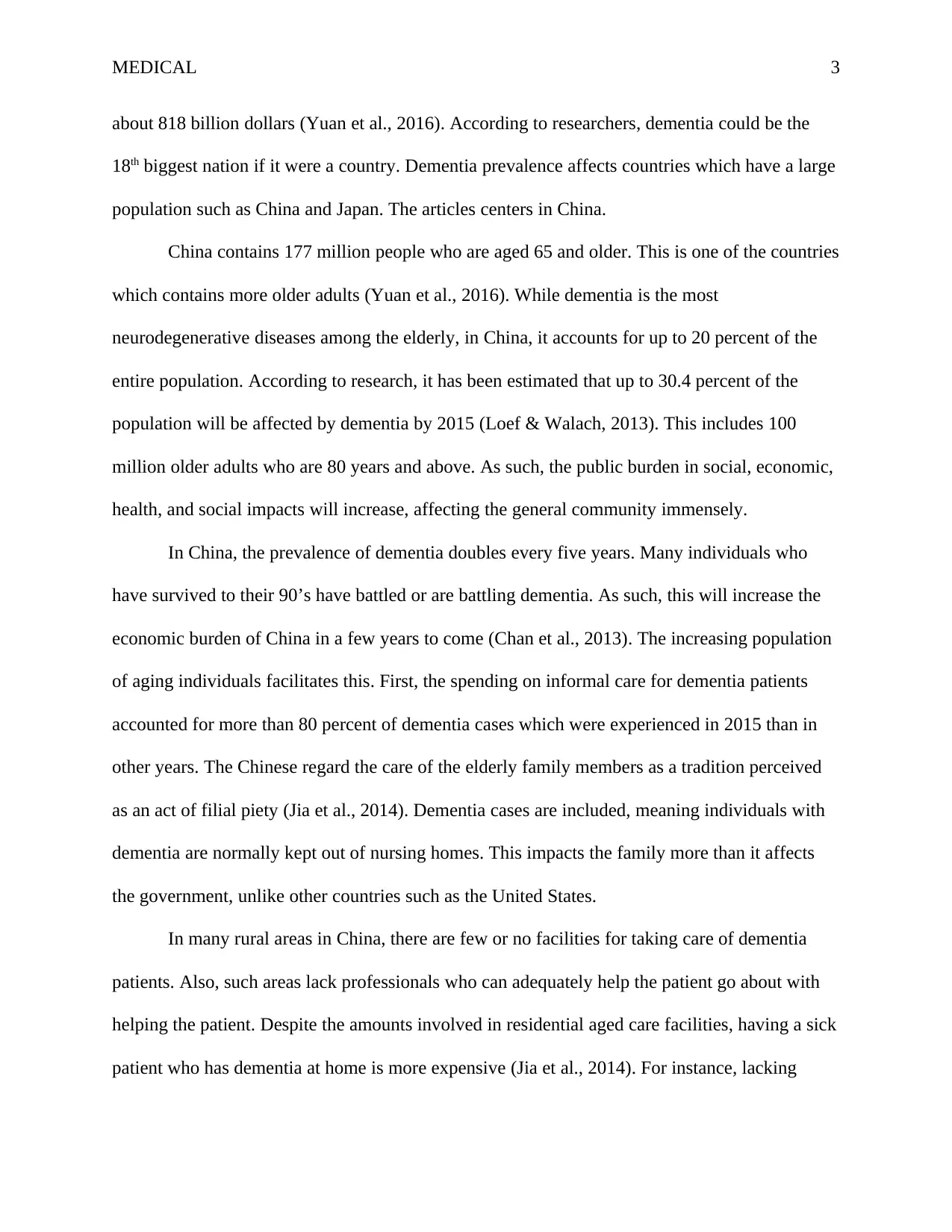
MEDICAL 3
about 818 billion dollars (Yuan et al., 2016). According to researchers, dementia could be the
18th biggest nation if it were a country. Dementia prevalence affects countries which have a large
population such as China and Japan. The articles centers in China.
China contains 177 million people who are aged 65 and older. This is one of the countries
which contains more older adults (Yuan et al., 2016). While dementia is the most
neurodegenerative diseases among the elderly, in China, it accounts for up to 20 percent of the
entire population. According to research, it has been estimated that up to 30.4 percent of the
population will be affected by dementia by 2015 (Loef & Walach, 2013). This includes 100
million older adults who are 80 years and above. As such, the public burden in social, economic,
health, and social impacts will increase, affecting the general community immensely.
In China, the prevalence of dementia doubles every five years. Many individuals who
have survived to their 90’s have battled or are battling dementia. As such, this will increase the
economic burden of China in a few years to come (Chan et al., 2013). The increasing population
of aging individuals facilitates this. First, the spending on informal care for dementia patients
accounted for more than 80 percent of dementia cases which were experienced in 2015 than in
other years. The Chinese regard the care of the elderly family members as a tradition perceived
as an act of filial piety (Jia et al., 2014). Dementia cases are included, meaning individuals with
dementia are normally kept out of nursing homes. This impacts the family more than it affects
the government, unlike other countries such as the United States.
In many rural areas in China, there are few or no facilities for taking care of dementia
patients. Also, such areas lack professionals who can adequately help the patient go about with
helping the patient. Despite the amounts involved in residential aged care facilities, having a sick
patient who has dementia at home is more expensive (Jia et al., 2014). For instance, lacking
about 818 billion dollars (Yuan et al., 2016). According to researchers, dementia could be the
18th biggest nation if it were a country. Dementia prevalence affects countries which have a large
population such as China and Japan. The articles centers in China.
China contains 177 million people who are aged 65 and older. This is one of the countries
which contains more older adults (Yuan et al., 2016). While dementia is the most
neurodegenerative diseases among the elderly, in China, it accounts for up to 20 percent of the
entire population. According to research, it has been estimated that up to 30.4 percent of the
population will be affected by dementia by 2015 (Loef & Walach, 2013). This includes 100
million older adults who are 80 years and above. As such, the public burden in social, economic,
health, and social impacts will increase, affecting the general community immensely.
In China, the prevalence of dementia doubles every five years. Many individuals who
have survived to their 90’s have battled or are battling dementia. As such, this will increase the
economic burden of China in a few years to come (Chan et al., 2013). The increasing population
of aging individuals facilitates this. First, the spending on informal care for dementia patients
accounted for more than 80 percent of dementia cases which were experienced in 2015 than in
other years. The Chinese regard the care of the elderly family members as a tradition perceived
as an act of filial piety (Jia et al., 2014). Dementia cases are included, meaning individuals with
dementia are normally kept out of nursing homes. This impacts the family more than it affects
the government, unlike other countries such as the United States.
In many rural areas in China, there are few or no facilities for taking care of dementia
patients. Also, such areas lack professionals who can adequately help the patient go about with
helping the patient. Despite the amounts involved in residential aged care facilities, having a sick
patient who has dementia at home is more expensive (Jia et al., 2014). For instance, lacking
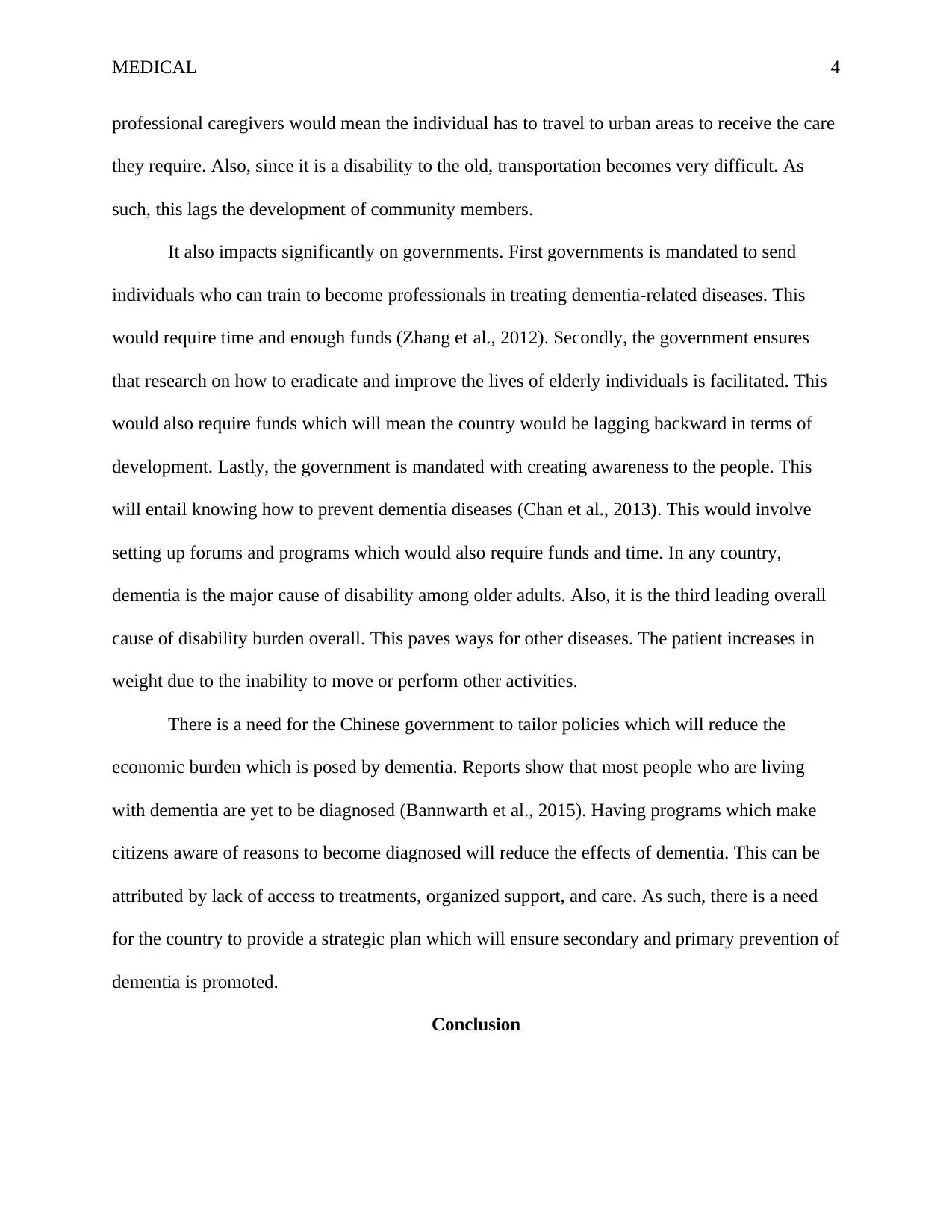
MEDICAL 4
professional caregivers would mean the individual has to travel to urban areas to receive the care
they require. Also, since it is a disability to the old, transportation becomes very difficult. As
such, this lags the development of community members.
It also impacts significantly on governments. First governments is mandated to send
individuals who can train to become professionals in treating dementia-related diseases. This
would require time and enough funds (Zhang et al., 2012). Secondly, the government ensures
that research on how to eradicate and improve the lives of elderly individuals is facilitated. This
would also require funds which will mean the country would be lagging backward in terms of
development. Lastly, the government is mandated with creating awareness to the people. This
will entail knowing how to prevent dementia diseases (Chan et al., 2013). This would involve
setting up forums and programs which would also require funds and time. In any country,
dementia is the major cause of disability among older adults. Also, it is the third leading overall
cause of disability burden overall. This paves ways for other diseases. The patient increases in
weight due to the inability to move or perform other activities.
There is a need for the Chinese government to tailor policies which will reduce the
economic burden which is posed by dementia. Reports show that most people who are living
with dementia are yet to be diagnosed (Bannwarth et al., 2015). Having programs which make
citizens aware of reasons to become diagnosed will reduce the effects of dementia. This can be
attributed by lack of access to treatments, organized support, and care. As such, there is a need
for the country to provide a strategic plan which will ensure secondary and primary prevention of
dementia is promoted.
Conclusion
professional caregivers would mean the individual has to travel to urban areas to receive the care
they require. Also, since it is a disability to the old, transportation becomes very difficult. As
such, this lags the development of community members.
It also impacts significantly on governments. First governments is mandated to send
individuals who can train to become professionals in treating dementia-related diseases. This
would require time and enough funds (Zhang et al., 2012). Secondly, the government ensures
that research on how to eradicate and improve the lives of elderly individuals is facilitated. This
would also require funds which will mean the country would be lagging backward in terms of
development. Lastly, the government is mandated with creating awareness to the people. This
will entail knowing how to prevent dementia diseases (Chan et al., 2013). This would involve
setting up forums and programs which would also require funds and time. In any country,
dementia is the major cause of disability among older adults. Also, it is the third leading overall
cause of disability burden overall. This paves ways for other diseases. The patient increases in
weight due to the inability to move or perform other activities.
There is a need for the Chinese government to tailor policies which will reduce the
economic burden which is posed by dementia. Reports show that most people who are living
with dementia are yet to be diagnosed (Bannwarth et al., 2015). Having programs which make
citizens aware of reasons to become diagnosed will reduce the effects of dementia. This can be
attributed by lack of access to treatments, organized support, and care. As such, there is a need
for the country to provide a strategic plan which will ensure secondary and primary prevention of
dementia is promoted.
Conclusion
Secure Best Marks with AI Grader
Need help grading? Try our AI Grader for instant feedback on your assignments.

MEDICAL 5
As such, in China, the community is greatly affected by dementia patients. These impacts
revolve on the spending of the community and the government while they eradicate dementia.
Increased disability and work rate among the old and increased funding to ensure the research of
the same is undertaken.
As such, in China, the community is greatly affected by dementia patients. These impacts
revolve on the spending of the community and the government while they eradicate dementia.
Increased disability and work rate among the old and increased funding to ensure the research of
the same is undertaken.
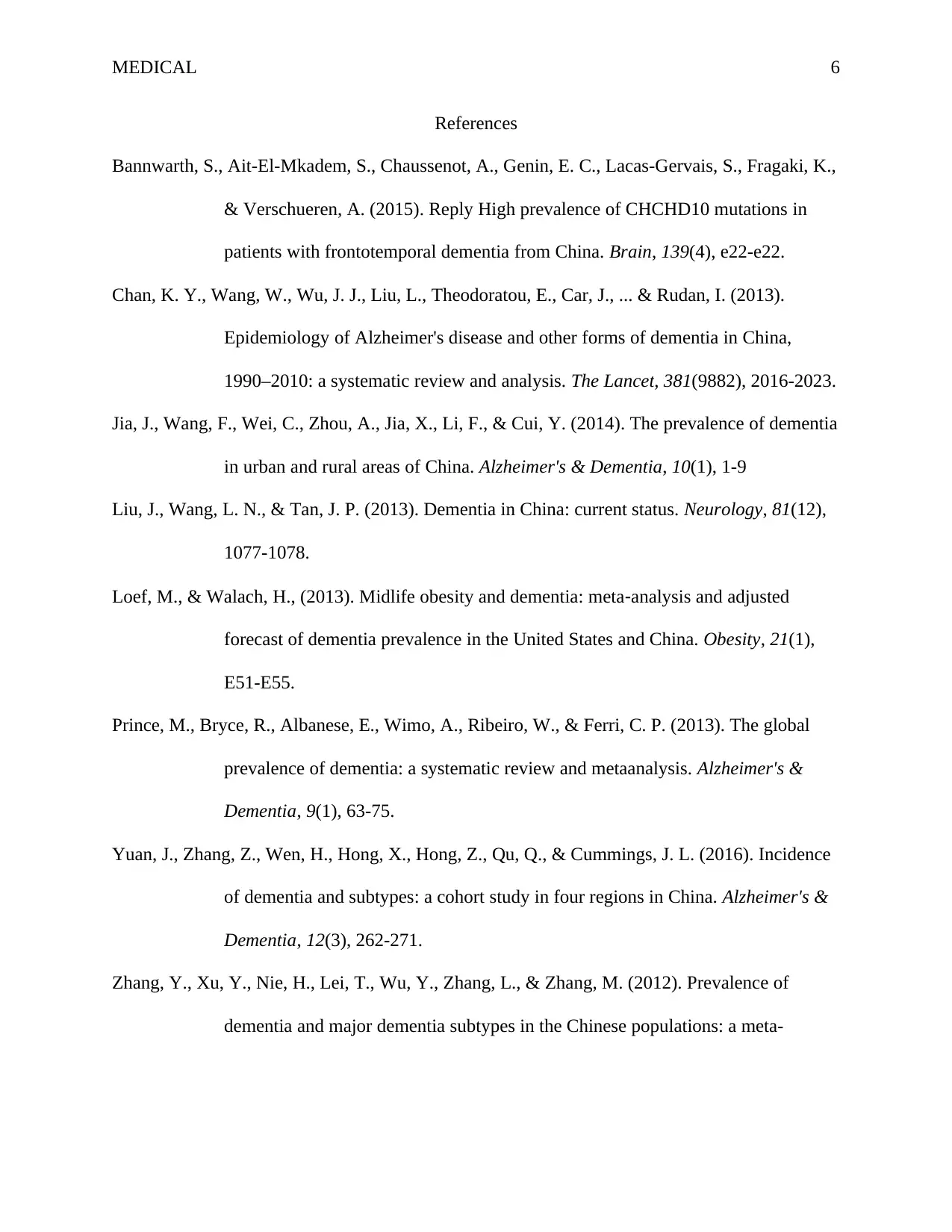
MEDICAL 6
References
Bannwarth, S., Ait-El-Mkadem, S., Chaussenot, A., Genin, E. C., Lacas-Gervais, S., Fragaki, K.,
& Verschueren, A. (2015). Reply High prevalence of CHCHD10 mutations in
patients with frontotemporal dementia from China. Brain, 139(4), e22-e22.
Chan, K. Y., Wang, W., Wu, J. J., Liu, L., Theodoratou, E., Car, J., ... & Rudan, I. (2013).
Epidemiology of Alzheimer's disease and other forms of dementia in China,
1990–2010: a systematic review and analysis. The Lancet, 381(9882), 2016-2023.
Jia, J., Wang, F., Wei, C., Zhou, A., Jia, X., Li, F., & Cui, Y. (2014). The prevalence of dementia
in urban and rural areas of China. Alzheimer's & Dementia, 10(1), 1-9
Liu, J., Wang, L. N., & Tan, J. P. (2013). Dementia in China: current status. Neurology, 81(12),
1077-1078.
Loef, M., & Walach, H., (2013). Midlife obesity and dementia: meta‐analysis and adjusted
forecast of dementia prevalence in the United States and China. Obesity, 21(1),
E51-E55.
Prince, M., Bryce, R., Albanese, E., Wimo, A., Ribeiro, W., & Ferri, C. P. (2013). The global
prevalence of dementia: a systematic review and metaanalysis. Alzheimer's &
Dementia, 9(1), 63-75.
Yuan, J., Zhang, Z., Wen, H., Hong, X., Hong, Z., Qu, Q., & Cummings, J. L. (2016). Incidence
of dementia and subtypes: a cohort study in four regions in China. Alzheimer's &
Dementia, 12(3), 262-271.
Zhang, Y., Xu, Y., Nie, H., Lei, T., Wu, Y., Zhang, L., & Zhang, M. (2012). Prevalence of
dementia and major dementia subtypes in the Chinese populations: a meta-
References
Bannwarth, S., Ait-El-Mkadem, S., Chaussenot, A., Genin, E. C., Lacas-Gervais, S., Fragaki, K.,
& Verschueren, A. (2015). Reply High prevalence of CHCHD10 mutations in
patients with frontotemporal dementia from China. Brain, 139(4), e22-e22.
Chan, K. Y., Wang, W., Wu, J. J., Liu, L., Theodoratou, E., Car, J., ... & Rudan, I. (2013).
Epidemiology of Alzheimer's disease and other forms of dementia in China,
1990–2010: a systematic review and analysis. The Lancet, 381(9882), 2016-2023.
Jia, J., Wang, F., Wei, C., Zhou, A., Jia, X., Li, F., & Cui, Y. (2014). The prevalence of dementia
in urban and rural areas of China. Alzheimer's & Dementia, 10(1), 1-9
Liu, J., Wang, L. N., & Tan, J. P. (2013). Dementia in China: current status. Neurology, 81(12),
1077-1078.
Loef, M., & Walach, H., (2013). Midlife obesity and dementia: meta‐analysis and adjusted
forecast of dementia prevalence in the United States and China. Obesity, 21(1),
E51-E55.
Prince, M., Bryce, R., Albanese, E., Wimo, A., Ribeiro, W., & Ferri, C. P. (2013). The global
prevalence of dementia: a systematic review and metaanalysis. Alzheimer's &
Dementia, 9(1), 63-75.
Yuan, J., Zhang, Z., Wen, H., Hong, X., Hong, Z., Qu, Q., & Cummings, J. L. (2016). Incidence
of dementia and subtypes: a cohort study in four regions in China. Alzheimer's &
Dementia, 12(3), 262-271.
Zhang, Y., Xu, Y., Nie, H., Lei, T., Wu, Y., Zhang, L., & Zhang, M. (2012). Prevalence of
dementia and major dementia subtypes in the Chinese populations: a meta-

MEDICAL 7
analysis of dementia prevalence surveys, 1980–2010. Journal of Clinical
Neuroscience, 19(10), 1333-1337.
analysis of dementia prevalence surveys, 1980–2010. Journal of Clinical
Neuroscience, 19(10), 1333-1337.
1 out of 7
Related Documents
Your All-in-One AI-Powered Toolkit for Academic Success.
+13062052269
info@desklib.com
Available 24*7 on WhatsApp / Email
![[object Object]](/_next/static/media/star-bottom.7253800d.svg)
Unlock your academic potential
© 2024 | Zucol Services PVT LTD | All rights reserved.





